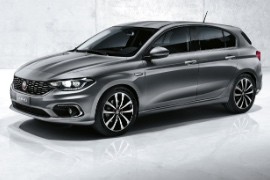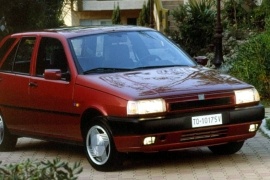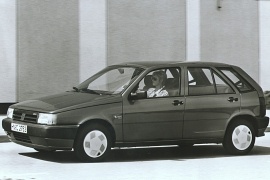FIAT Tipo 5 Doors Models/Series Timeline, Specifications & Photos
First production year: 1988
Engines: Diesel, Gasoline
Body style: Hatchback
Fiat revived the Tipo nameplate in 2015 by creating a new vehicle in three shapes: sedan, station wagon, and hatchback, and all of them were built on a budget in Turkey.
Fiat's financial status was not on the bright side of the balance anymore, and the Italian carmaker needed a solution to sell more cars, and it needed it fast. Also, it needed solutions to build this car on a budget and sell it with a profit even though it was affordable. But since we're talking about Fiat, they found a way to do that.
The hatchback was not the first to reach the assembly lines in Turkey. It came second and featured the same front fascia as its three-box sibling. Regardless of the car's qualities, it was well designed, with angry-looking headlights that flanked a chromed mesh grille which, in turn, supported the Fiat badge in the middle. It shared the same A- and B-pillars with the sedan and the station wagon, but from there on, there was a significant difference at the C-pillar, which concluded the greenhouse's shape at the back, supporting the tailgate. Moreover, all versions received a roof spoiler with integrated third brake light.
Inside, Fiat installed the same dashboard as in the station wagon, with a larger infotainment screen than in the sedan, and that was an option. But the customers shouldn't expect a high-quality interior or leather seats. Also, it shared the same rear bench with the station wagon, which expanded the otherwise small trunk.
Fiat didn't want to invest too much in this project built atop an existing platform and installed already developed diesel and gasoline engines.
Fiat introduced the Tipo lineup in 1988 as a replacement for the Ritmo, and five years later, the Italian carmaker brought a refreshed version.
The Tipo was a huge success right from the start. It offered more than its main rivals, and it was priced lower. Moreover, it came after the Ritmo, which was another successful vehicle built by Fiat. Fiat introduced a three-door version along with the facelifted version as well, but the main selling version was the five-door hatchback.
Designed by Ercole Espada, the Tipo surprised with its modern lines for those times. To stay ahead of the other hatchbacks, the carmaker changed some exterior details. It featured a new front fascia with slimmer headlights and a horizontal bar on top of the grille, with the four oblique Fiat brand lines. Since it was based on the 1988 model, it still featured a cubist-style design, but it was more rounded this time. On the sides, the body-colored door mirrors fitted better than the black ones from the non-facelifted version.
The Tipo offered one of the largest cabins in its class, and that was kept even after the facelift, but Fiat worked on some details. Inside, the designer followed the straight-line theme from the exterior and imagined a dashboard with long and flat surfaces. Even the instrument cluster was designed with angular lines with a grid pattern in the background. Obviously, it featured a split-folding rear bench to expand the, otherwise, small trunk.
Fiat installed a small engine choice under the hood, but good enough for the average buyers who were looking for an affordable, easy-to-run vehicle. There were three gasoline and two turbo-diesel engine options and, besides the 2.0-liter gasoline unit, all of the others were very fuel-efficient.
Fiat unveiled the Tipo in 1988 as a replacement for the aged Ritmo, who was on the market for ten years. It was available only as a 5-door version.
Fiat considered that a hatchback had to have five doors appealing to families, and it sees no reason for making it with three doors. Later on, in 1993, it understood that 3-doors hatchbacks were a big part of the market and fixed their mistake. But for five years, the 5-door was the only option to go for a Tipo.
The car was designed by I.DE.A institute by a former lead-designer from Zagato, Ercole Spada. He used straight or slightly curved lines to create an appealing look for the Tipo. Moreover, it designed it to be built as a sedan and still keep most of the body panels. The wrap-around plastic bumper visually enhanced the rectangular headlights and flat front fascia. A slightly ascending beltline ran across the vehicle up to the D-pillar since the Tipo featured an additional glass area behind the rear doors.
Inside, the designer followed the straight-lines theme from the exterior and imagined a dashboard with long and flat surfaces. Even the instrument cluster was designed with angular lines with a grid pattern in the background.
Under the hood, Fiat installed a wide choice of engines. There were six gasoline and three diesel versions. The latter was on an ascending trend on the market, and hence Fiat's expertise in compression ignition engines was big. It didn't want to lose those customers.


